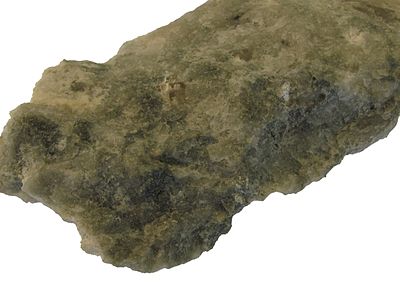Weberite
| Weberite | |
|---|---|
| Weberite (greenish gray) in cryolite from Ivittuut, Greenland | |
| General and classification | |
| chemical formula |
|
|
Mineral class (and possibly department) |
Halides |
|
System no. to Strunz and to Dana |
3.CB.25 ( 8th edition : III / C.03) 06/11/13/01 |
| Crystallographic Data | |
| Crystal system | orthorhombic |
| Crystal class ; symbol | orthorhombic-pyramidal; mm 2 |
| Room group (no.) | Imm 2 ( I 2 mm ) (No. 44) |
| Lattice parameters | a = 7.05 Å ; b = 9.97 Å; c = 7.28 Å |
| Formula units | Z = 4 |
| Frequent crystal faces | {001}, {010}, {110}, {011}, {101}, {111}, {131} |
| Physical Properties | |
| Mohs hardness | 3.5 |
| Density (g / cm 3 ) | measured: 2.96; calculated: 2.966 |
| Cleavage | indistinct after {010} |
| Break ; Tenacity | uneven |
| colour | white, light gray, gray-green, rarely also light orange |
| Line color | White |
| transparency | translucent |
| shine | Glass gloss |
| Crystal optics | |
| Refractive indices |
n α = 1.346 n β = 1.348 n γ = 1.350 |
| Birefringence | δ = 0.004 |
| Optical character | biaxial positive |
| Axis angle | 2V = 83 ° (measured); 88 ° (calculated) |
| Other properties | |
| Chemical behavior | easily soluble in water |
Weberite is a rarely occurring mineral from the mineral class of " halides ". It crystallizes in the orthorhombic crystal system with the chemical composition Na 2 MgAlF 7 .
Weberite is translucent and is mostly found in the form of irregular grains and massive aggregates as well as inclusions in cryolite or grown together with fluorite . However, it rarely forms small, pseudo-cubic-octahedral crystals . In its pure form, Weberite is white, but it can also appear light gray, gray-green and, rarely, light orange due to foreign admixtures. However, its line color is always white and in transmitted light it is colorless.
Special properties
Weberite is easily soluble in water.
Etymology and history
Weberit was in 1938 by Richard Bøgvad in the (1897-1952) cryolite - deposit at Ivittuut in Greenland discovered that the minerals by Theobald Weber named (1823-1886), one of the founders of the Danish cryolite industry. The crystal structure was solved by Anders Byström six years later.
classification
In the meanwhile outdated, but still in use 8th edition of the mineral classification according to Strunz , the Weberite belonged to the general division of the "hydrous double halides", where together with Carlhintzeit , Chiolith , Karasugit , Neighborit , Prosopit , Ralstonite , Rosenbergit and Usovit the "Chiolite- Ralstonite Group "with the system no. III / C.03 formed.
In the 9th edition of Strunz's mineral systematics , which has been in effect since 2001 and is used by the International Mineralogical Association (IMA) , the department was renamed “Complex Halides” and further subdivided according to the crystal structure of the minerals sorted there, so that the Weberite can be structured according to its structure in the subdivision of the "Island-Aluminofluoride (Neso-Aluminofluoride)" can be found, where he is the only member of the unnamed group 3.CB.25 .
The systematics of minerals according to Dana , which is mainly used in the English-speaking world , assigns Weberite to the division of "Complex Halides - Aluminum Fluorides". Here he is the only member of the unnamed group 11.06.13 within the sub-section “ Complex halides - aluminum fluorides with different formulas ”.
Education and Locations
Weberite forms in cryolite deposits and overlying pegmatites . In addition to cryolite, accompanying minerals can include chiolite , fluorite , galena , jarlite , pachnolite , prosopite , pyrite , ralstonite , stenonite , thomsenolite and topaz .
As a rare mineral formation, Weberite has so far (as of 2012) only been detected at around 10 sites, whereby its type locality Ivittuut is the only known site in Greenland to date. The mineral was also found on Deception Island in Antarctica, at Iron Knob and Waratah in Tasmania in Australia, on Akzhaylyautas in the Tarbagatai Mountains in eastern Kazakhstan , in the Perzhanskoe ore field in the Ukrainian Oblast of Zhytomyr and at some sites in the US - States of Colorado and Nevada .
Crystal structure
Weberite crystallizes orthorhombically in the space group Imm 2 ( I 2 mm ; space group no. 44) with the lattice parameters a = 7.05 Å ; b = 9.97 Å and c = 7.28 Å as well as four formula units per unit cell .
The Mg 2+ and Al 3+ cations are each octahedrally coordinated by six fluorine atoms. The [MgF 6 ] octahedra form chains via transkant linkages that run along the [100] direction. These chains are connected to one another by the [AlF 6 ] octahedra, with only four fluoride anions of the [AlF 6 ] octahedra also participating in the linkage.
See also
literature
- Anders Byström: Arkiv för kemi , in: Mineralogi och Geologi , Volume 18A (1945), pp. 1-8
Web links
Individual evidence
- ↑ a b IMA / CNMNC List of Mineral Names (PDF 1.8 MB; p. 303)
- ↑ a b c d Hugo Strunz , Ernest H. Nickel: Strunz Mineralogical Tables . 9th edition. E. Schweizerbart'sche Verlagbuchhandlung (Nägele and Obermiller), Stuttgart 2001, ISBN 3-510-65188-X , p. 162 .
- ↑ a b c d John W. Anthony, Richard A. Bideaux, Kenneth W. Bladh, Monte C. Nichols: Weberite , in: Handbook of Mineralogy, Mineralogical Society of America , 2001 ( PDF 69.5 kB )
- ↑ a b c d Mindat - Weberite
- ^ Arne Noe-Nygaard: Richard Bøgvad , in: Medd. fra Dansk Geologisk Forening , Volume 12, København 1952, pp. 315–318 ( PDF 988.5 kB )
